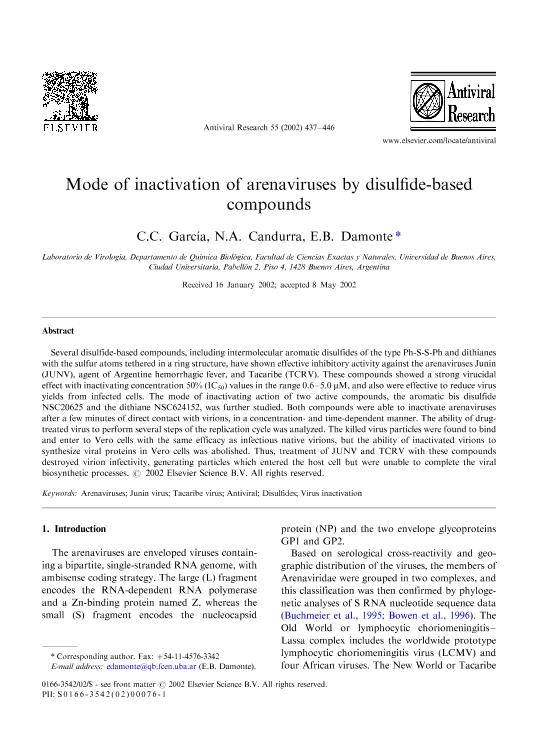Artículo
Mode of inactivation of arenaviruses by disulfide-based compounds
Fecha de publicación:
12/2002
Editorial:
Elsevier Science
Revista:
Antiviral Research
ISSN:
0166-3542
Idioma:
Inglés
Tipo de recurso:
Artículo publicado
Clasificación temática:
Resumen
Several disulfide-based compounds, including intermolecular aromatic disulfides of the type Ph-S-S-Ph and dithianes with the sulfur atoms tethered in a ring structure, have shown effective inhibitory activity against the arenaviruses Junin (JUNV), agent of Argentine hemorrhagic fever, and Tacaribe (TCRV). These compounds showed a strong virucidal effect with inactivating concentration 50% (IC50) values in the range 0.6 /5.0 mM, and also were effective to reduce virus yields from infected cells. The mode of inactivating action of two active compounds, the aromatic bis disulfide NSC20625 and the dithiane NSC624152, was further studied. Both compounds were able to inactivate arenaviruses after a few minutes of direct contact with virions, in a concentration- and time-dependent manner. The ability of drugtreated virus to perform several steps of the replication cycle was analyzed. The killed virus particles were found to bind and enter to Vero cells with the same efficacy as infectious native virions, but the ability of inactivated virions to synthesize viral proteins in Vero cells was abolished. Thus, treatment of JUNV and TCRV with these compounds destroyed virion infectivity, generating particles which entered the host cell but were unable to complete the viral biosynthetic processes.
Palabras clave:
arenavirus
,
Virus inactivation
,
disulfides
,
Junin virus
,
Tacaribe virus
,
Antiviral
Archivos asociados
Licencia
Identificadores
Colecciones
Articulos(IQUIBICEN)
Articulos de INSTITUTO DE QUIMICA BIOLOGICA DE LA FACULTAD DE CS. EXACTAS Y NATURALES
Articulos de INSTITUTO DE QUIMICA BIOLOGICA DE LA FACULTAD DE CS. EXACTAS Y NATURALES
Citación
Garcia, Cybele; Candurra, Nélida A.; Damonte, Elsa Beatriz; Mode of inactivation of arenaviruses by disulfide-based compounds; Elsevier Science; Antiviral Research; 55; 12-2002; 437-446
Compartir
Altmétricas




